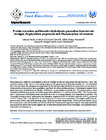Protein extraction and bioactive hydrolysate generation from two microalgae, Porphyridium purpureum and Phaeodactylum tricornutum
Citation
Stack, J., Le Gouic, A.V., Tobin, P.R., Guihéneuf, F., Stengel, D.B., and FitzGerald, R.J. (2018). Protein extraction and bioactive hydrolysate generation from two microalgae, Porphyridium purpureum and Phaeodactylum tricornutum. J. Food Bioact. 1: 153–165.

View/
Date
2018Author
Stack, Julianne
Le Gouic, Aurélien V.
Tobin, Paul R.
Guihéneuf, Freddy
Stengel, Dagmar B.
FitzGerald, Richard J.
Peer Reviewed
YesMetadata
Show full item record
Stack, J., Le Gouic, A.V., Tobin, P.R., Guihéneuf, F., Stengel, D.B., and FitzGerald, R.J. (2018). Protein extraction and bioactive hydrolysate generation from two microalgae, Porphyridium purpureum and Phaeodactylum tricornutum. J. Food Bioact. 1: 153–165.
Abstract
Microalgae are a relatively underutilised source of valuable nutritional compounds and biochemicals. Their high protein contents make them an interesting target for the generation of bioactive peptides for the functional food industry. Here, the nitrogenous components of the red microalga Porphyridium purpureum and the diatom-Phaeodactylum tricornutum were quantified, and their SDS-PAGE profiles analysed. Proteinswere isolated from these species by solubilisation at alkaline pH followed by precipitation at acidic pH. The protein extracts were hydrolysed with the food-grade proteolytic preparations Alcalase 2.4 L and Flavourzyme 500 L. The P. purpureum and P. tricornutum hydrolysates were examined for their in vitroanti-diabetic and antioxidant properties. The
microalgal-derived protein hydrolysates had dipeptidyl peptidase (DPP) IV inhibitory activity, with IC50 values of 2.28 ± 0.36 and 2.68 ± 0.19 mg/mL for P. purpureum and P. tricornutum, respectively. The oxygen radical absorbance capacity (ORAC) and ferric reducing power (FRAP) values were, respectively, 13.98 ± 0.97 and 478.94 ± 34.43 for P. purpureum, and 15.04 ± 0.54 and 155.74 ± 38.30 for P. tricornutum expressed in μmol Trolox Equivalent (TE) per gram of dry matter.The results suggest that protein hydrolysates from these microalgae have potential use as functional food ingredients.
Keywords
Porphyridium purpureumPhaeodactylum tricornutum
Bioactive peptides
Protein hydrolysates
Antioxidant
DPP-IV

